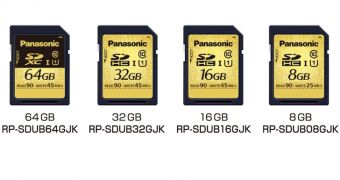There are rugged consumer electronics devices and components, and then there are the Panasonic UHS-I-level SDAB and SDUB series of SDHC and SDXC memory cards.
Objectively speaking, the memory cards do, indeed, qualify as “rugged”. The only reason we don't think that adjective works all that well for them is because the UHS-I-level SDAB and SDUB are in a level of their own in terms of endurance.
Over the years, we've seen the word “rugged” used for anything with even the smallest physical protection in place.
Panasonic's memory cards reach the upper limit of what is recommended for consumer and business gadgets and then smash through it and keep going for a while longer.
For one, the cards can be submerged underwater at a depth of 3.3 feet (one meter) and left there for half an hour without any ill effects.
Secondly, the products are resistant to magnetic energy and will weather even direct electrical shocks without a hitch.
Thirdly, the NAND Flash-based storage cards are resistant against X-Ray radiation.
Only the tolerance for cold is relatively tame (-13 degrees Fahrenheit / -25 degrees Celsius), but even that is completely compensated (to say the least) by the heat resistance (185 degrees Fahrenheit / 85 degrees Celsius).
Panasonic was able to implement this advanced physical toughness, along with fused insides (to prevent fire from burning the cards from within) without sacrificing performance. Weather-resistant cameras and other equipment taken to unfriendly environments will benefit greatly from their use.
Thus, the SDAB (8 to 32 GB) read data at 95 MB/s and write it at 80 MB/s, while the SDUB (8 to 64 GB) read at 90 MB/s and write at 45 MB/s.
We don't know what the prices are, unfortunately, and we probably won't learn them until Panasonic sends the cards to EU or the US, if ever. Right now, they are only official in Japan.

 14 DAY TRIAL //
14 DAY TRIAL //